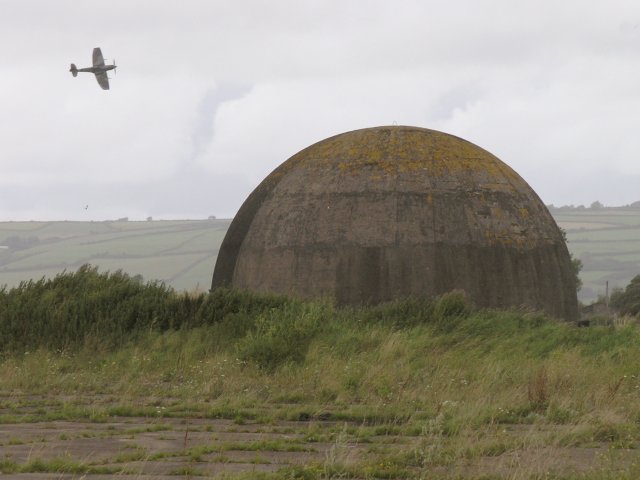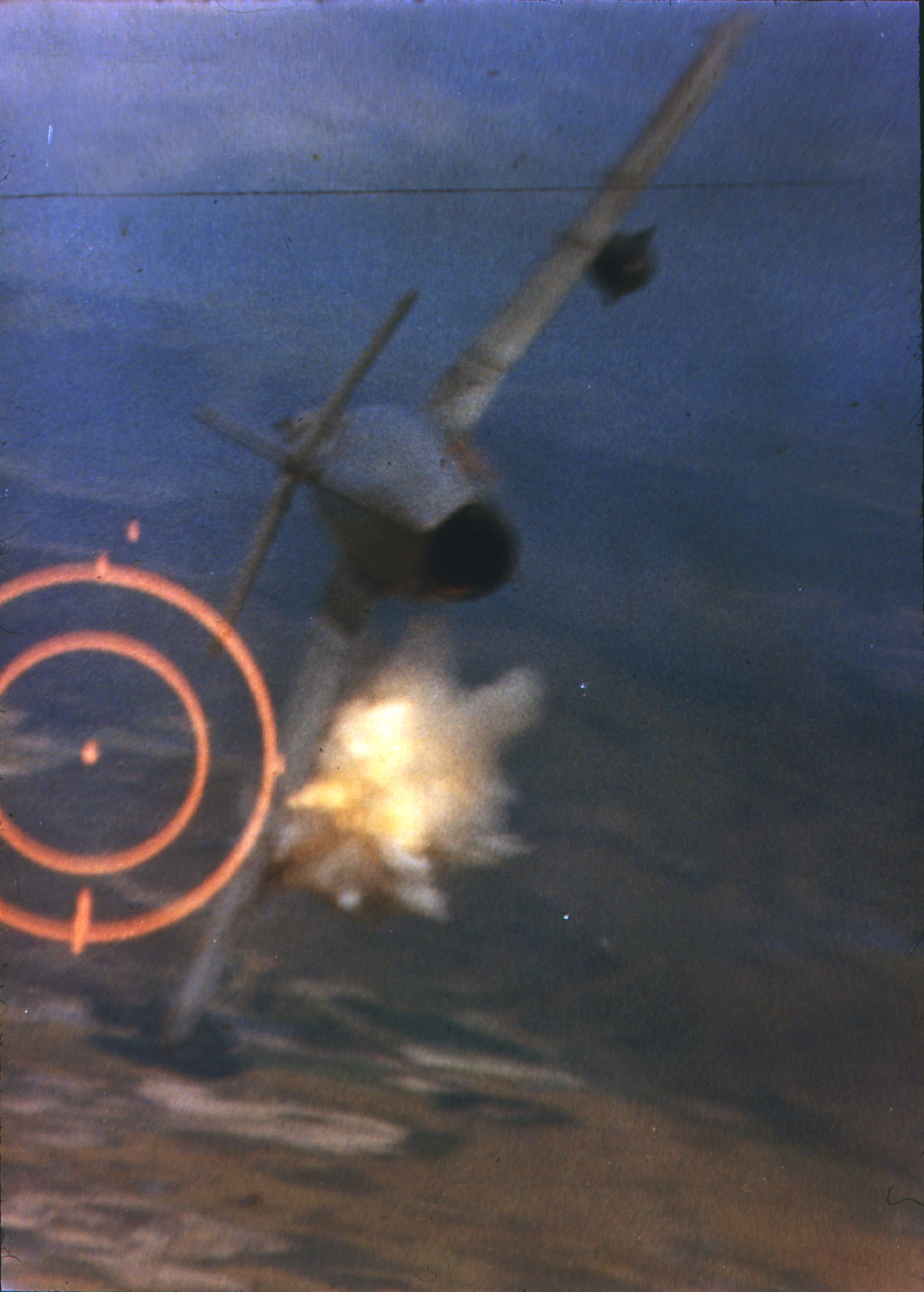|
RAF Pembrey
Pembrey Sands Air Weapons Range is a Ministry of Defence air weapons range located near the village of Pembrey, Carmarthenshire, northwest of Burry Port and south of Carmarthen, Wales. Adjacent to the weapons range site was a Royal Air Force station known as RAF Pembrey which closed is 1957 and is now a in civilian use as Pembrey Airport. History RAF Pembrey Origin Construction of the airfield for RAF Training Command started in 1937. The airfield opened in March 1939, and by September 1939 the RAF's No. 2 Air Armament School was the first unit to be stationed at the airfield. Second World War By May 1940, the three tarmac runways were completed and the airfield transferred initially to 11 Group RAF Fighter Command and then to the newly formed 10 Group RAF Fighter Command. Supermarine Spitfire pilots of 92 Squadron used Pembrey as their base from 18 June 1940, including Squadron Leader Stanford Tuck, until 12 August, Geoffrey Wellum the author of the 2002 memoir, ... [...More Info...] [...Related Items...] OR: [Wikipedia] [Google] [Baidu] |
Royal Air Force Station
The Royal Air Force (RAF) operates several stations throughout the United Kingdom and overseas. This includes front-line and training air bases, support, administrative and training stations with no flying activity, unmanned airfields used for training, intelligence gathering stations and an early warning radar network. The list also includes RAF stations operated by the United States Visiting Forces, former RAF stations now operated by defence contractor QinetiQ on behalf the Ministry of Defence (MOD) and air weapons ranges operated by the MOD. Overseas, the RAF operates airfields at four Permanent Joint Operating Bases (PJOBs) which are located in British Overseas Territories. RAF stations and MOD airfields in the UK Royal Air Force RAF front-line operations are centred on seven main operating bases (MOBs): * RAF Coningsby, RAF Marham and RAF Lossiemouth (Air Combat) * RAF Waddington ( Combat Intelligence, Surveillance Target Acquisition and Reconnaissance) * RAF ... [...More Info...] [...Related Items...] OR: [Wikipedia] [Google] [Baidu] |
Pembrey
Pembrey (Welsh: ''Pen-bre'') is a village in Carmarthenshire, Wales, situated between Burry Port and Kidwelly, overlooking Carmarthen Bay, with a population of about 2,154 in 2011. The electoral ward having a population of 4,301. It is in the community of Pembrey and Burry Port Town. History The name Pembrey is an Anglicisation of the Welsh, ''Pen-bre''. "Pen" is a Welsh word meaning head or top, and "bre" is an old Celtic word for a promontory. The coastline began its retreat from the foot of Pembrey Mountain some 6,000 years ago, revealing land which shows human occupation since the Iron Age, with hill forts dating from around 400 BC. The population of the region was known to the Romans as Demetae. Roman pottery remains have been unearthed in the oldest parts of the village. Later, the village was part of the Welsh principality of Deheubarth. Evidence of an early Norman motte-and-bailey castle has been suggested close to the village square and buildings remain in the villag ... [...More Info...] [...Related Items...] OR: [Wikipedia] [Google] [Baidu] |
Robert Stanford Tuck
Wing Commander Robert Roland Stanford Tuck, (1 July 1916 – 5 May 1987) was a British fighter pilot, flying ace and test pilot. Tuck joined the Royal Air Force (RAF) in 1935 and first engaged in combat during the Battle of France, over Dunkirk, claiming his first victories. In September 1940 he was promoted to squadron leader and commanded a Hawker Hurricane squadron. In 1941–1942, Tuck participated in fighter sweeps over northern France. On 28 January 1942, he was hit by anti-aircraft fire, was forced to land in France, and was taken prisoner. At the time of his capture, Tuck had claimed 29 enemy aircraft destroyed, two shared destroyed, six probably destroyed, six damaged and one shared damaged. Early years Tuck was born in Catford, southeast London. After a less-than-stellar school career he left St Dunstan's College, Catford in 1932 to join the Merchant Navy as a sea cadet (seaman's Discharge Number R112769) aboard the SS ''Marconi'' from 19 May 1933 before joining the ... [...More Info...] [...Related Items...] OR: [Wikipedia] [Google] [Baidu] |
Cotentin Peninsula
The Cotentin Peninsula (, ; nrf, Cotentîn ), also known as the Cherbourg Peninsula, is a peninsula in Normandy that forms part of the northwest coast of France. It extends north-westward into the English Channel, towards Great Britain. To its west lie the Gulf of Saint-Malo and the Channel Islands, and to the southwest lies the peninsula of Brittany. The peninsula lies wholly within the department of Manche, in the region of Normandy. Geography The Cotentin peninsula is part of the Armorican Massif (with the exception of the Plain lying in the Paris Basin) and lies between the estuary of the Vire river and Mont Saint-Michel Bay. It is divided into three areas: the headland of Cap de la Hague, the Cotentin Pass (the Plain), and the valley of the Saire River (Val de Saire). It forms the bulk of the department of Manche. Its southern part, known as "le Marais" (the Marshlands), crosses from east to west from just north west of Saint Lo and east of Lessay and marks a natural bo ... [...More Info...] [...Related Items...] OR: [Wikipedia] [Google] [Baidu] |
English Channel
The English Channel, "The Sleeve"; nrf, la Maunche, "The Sleeve" (Cotentinais) or ( Jèrriais), (Guernésiais), "The Channel"; br, Mor Breizh, "Sea of Brittany"; cy, Môr Udd, "Lord's Sea"; kw, Mor Bretannek, "British Sea"; nl, Het Kanaal, "The Channel"; german: Ärmelkanal, "Sleeve Channel" ( French: ''la Manche;'' also called the British Channel or simply the Channel) is an arm of the Atlantic Ocean that separates Southern England from northern France. It links to the southern part of the North Sea by the Strait of Dover at its northeastern end. It is the busiest shipping area in the world. It is about long and varies in width from at its widest to at its narrowest in the Strait of Dover."English Channel". ''The Columbia Encyclopedia'', 2004. It is the smallest of the shallow seas around the continental shelf of Europe, covering an area of some . The Channel was a key factor in Britain becoming a naval superpower and has been utilised by Britain as a natural def ... [...More Info...] [...Related Items...] OR: [Wikipedia] [Google] [Baidu] |
Armin Faber
'' Oberleutnant'' Armin Faber was a German ''Luftwaffe'' pilot in World War II who mistook the Bristol Channel for the English Channel and landed his Focke-Wulf 190 (Fw 190) intact at RAF Pembrey in South Wales. His plane was the first Fw 190 to be captured by the Allies and was tested to reveal any weaknesses that could be exploited. 23 June 1942 In June 1942, ''Oberleutnant'' Armin Faber was ''Gruppen-Adjutant'' (performing administrative and personnel paperwork duties as well as flight duties) to the commander of the III fighter ''Gruppe'' of ''Jagdgeschwader 2'' (JG 2, Second Fighter Wing) based in Morlaix in Brittany. On 23 June, he was given special permission to fly a combat mission with 7th ''Staffel''; a unit that flew Focke-Wulf 190 fighters. The Fw 190 had only recently arrived with front line units at this time and its superior performance had caused the Allies so many problems that they were considering mounting a commando raid on a French airfield to capture on ... [...More Info...] [...Related Items...] OR: [Wikipedia] [Google] [Baidu] |
Bristol Channel
The Bristol Channel ( cy, Môr Hafren, literal translation: "Severn Sea") is a major inlet in the island of Great Britain, separating South Wales from Devon and Somerset in South West England. It extends from the lower estuary of the River Severn ( cy, Afon Hafren) to the North Atlantic Ocean. It takes its name from the English city of Bristol, and is over 30 miles (50 km) wide at its western limit. Long stretches of both sides of the coastline are designated as Heritage Coast. These include Exmoor, Bideford Bay, the Hartland Point peninsula, Lundy Island, Glamorgan, Gower Peninsula, Carmarthenshire, South Pembrokeshire and Caldey Island. Until Tudor times the Bristol Channel was known as the Severn Sea, and it is still known as this in both cy, Môr Hafren and kw, Mor Havren. Geography The International Hydrographic Organization now defines the western limit of the Bristol Channel as "a line joining Hartland Point in Devon () to St. Govan's Head in Pembrokeshire ... [...More Info...] [...Related Items...] OR: [Wikipedia] [Google] [Baidu] |
Dog Fight
A dogfight, or dog fight, is an air combat manoeuvring, aerial battle between fighter aircraft conducted at close range. Dogfighting first occurred in Mexico in 1913, shortly after the invention of the airplane. Until at least 1992, it was a component in every major war, though with steadily declining frequency. Since then, longer-range weapons have made dogfighting largely obsolete. Modern terminology for air-to-air combat is air combat maneuvering (ACM), which refers to tactical situations requiring the use of individual basic fighter maneuvers (BFM) to attack or evade one or more opponents. This differs from aerial warfare, which deals with the strategy involved in planning and executing various missions. Etymology The term ''dogfight'' has been used for centuries to describe a melee: a fierce, fast-paced close quarters battle between two or more opponents. The term gained popularity during World War II, although its origin in air combat can be traced to the latter years o ... [...More Info...] [...Related Items...] OR: [Wikipedia] [Google] [Baidu] |
Focke-Wulf Fw 190
The Focke-Wulf Fw 190, nicknamed ''Würger'' (" Shrike") is a German single-seat, single-engine fighter aircraft designed by Kurt Tank at Focke-Wulf in the late 1930s and widely used during World War II. Along with its well-known counterpart, the Messerschmitt Bf 109, the Fw 190 became the backbone of the (Fighter Force) of the . The twin-row BMW 801 radial engine that powered most operational versions enabled the Fw 190 to lift larger loads than the Bf 109, allowing its use as a day fighter, fighter-bomber, ground-attack aircraft and to a lesser degree, night fighter. The Fw 190A started flying operationally over France in August 1941 and quickly proved superior in all but turn radius to the Spitfire Mk. V, the main front-line fighter of the Royal Air Force (RAF), particularly at low and medium altitudes. The 190 maintained superiority over Allied fighters until the introduction of the improved Spitfire Mk. IX. In November/December 1942, the Fw 190 made its air combat ... [...More Info...] [...Related Items...] OR: [Wikipedia] [Google] [Baidu] |
Vickers Wellington
The Vickers Wellington was a British twin-engined, long-range medium bomber. It was designed during the mid-1930s at Brooklands in Weybridge, Surrey. Led by Vickers-Armstrongs' chief designer Rex Pierson; a key feature of the aircraft is its geodetic airframe fuselage structure, which was principally designed by Barnes Wallis. Development had been started in response to Air Ministry Specification B.9/32, issued in the middle of 1932, for a bomber for the Royal Air Force. This specification called for a twin-engined day bomber capable of delivering higher performance than any previous design. Other aircraft developed to the same specification include the Armstrong Whitworth Whitley and the Handley Page Hampden. During the development process, performance requirements such as for the tare weight changed substantially, and the engine used was not the one originally intended. The Wellington was used as a night bomber in the early years of the Second World War, performing as one o ... [...More Info...] [...Related Items...] OR: [Wikipedia] [Google] [Baidu] |
Bristol Blenheim
The Bristol Blenheim is a British light bomber aircraft designed and built by the Bristol Aeroplane Company (Bristol) which was used extensively in the first two years of the Second World War, with examples still being used as trainers until the end of the war. Development began with the ''Type 142'', a civil airliner, in response to a challenge from Lord Rothermere to produce the fastest commercial aircraft in Europe. The ''Type 142'' first flew in April 1935, and the Air Ministry, impressed by its performance, ordered a modified design as the ''Type 142M'' for the Royal Air Force (RAF) as a bomber. Deliveries of the newly named Blenheim to RAF squadrons commenced on 10 March 1937. In service the Type 142M became the Blenheim Mk.I which would be developed into the longer Type 149, designated the Blenheim Mk.IV, except in Canada where Fairchild Canada built the Type 149 under licence as the Bolingbroke. The Type 160 Bisley was also developed from the Blenheim, but was already o ... [...More Info...] [...Related Items...] OR: [Wikipedia] [Google] [Baidu] |







.jpg)

